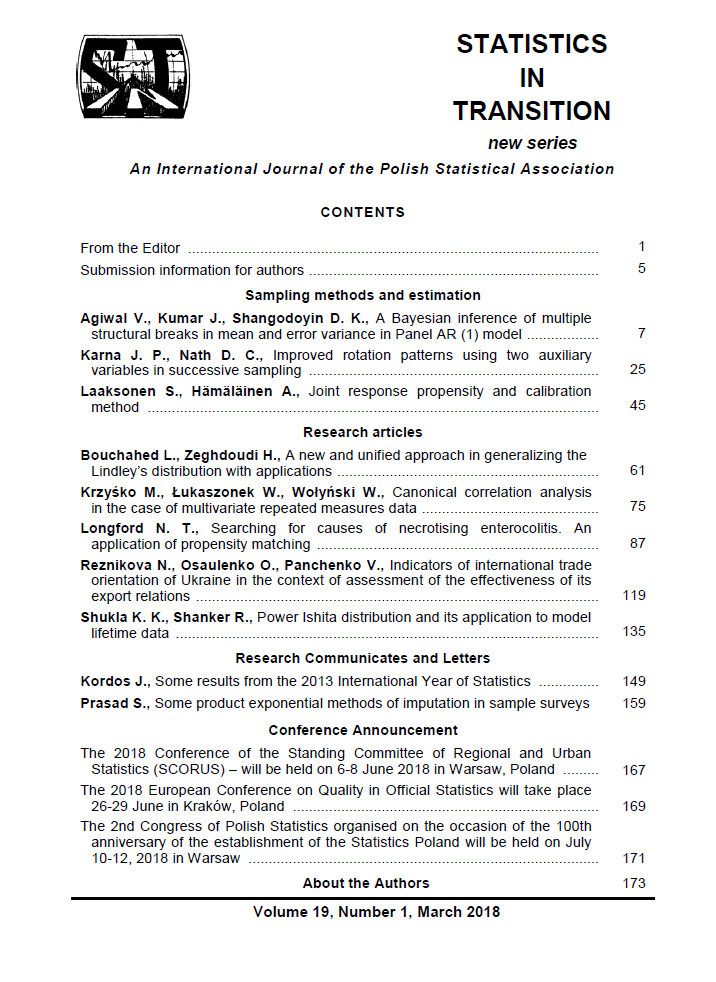ARTICLE
ABSTRACT
Necrotising enterocolitis (NEC) is a disease of the gastrointestinal tract afflicting preterm-born infants in the first few weeks of their lives. We estimate the effect of changing the feeding regimen of infants in their first 14 postnatal days by analysing the data from the UK National Neonatal Research Database. We avoid some problems with drawing causal inferences from observational data by reducing the analysis to the infants who spent the first 14 postnatal days (or longer) in neonatal care and for whom NEC was not suspected in this period. This reduction enables us to use summaries of the feeding regimen in this period as background variables in a potential outcomes framework. Large size of the cohort is a distinct advantage of our study. Its results inform the design of a randomised clinical trial for preventing NEC, and the choice of its active treatment(s) in particular.
KEYWORDS
causal analysis, National Neonatal Research Database, necrotising enterocolitis, potential outcomes framework, preterm birth, propensity matching.
REFERENCES
AMERICAN ACADEMY OF PEDIATRY, (2012). Breastfeeding and the use of hu man milk. Policy statement. Pediatrics 129, pp. e827–e841.
ARSLANOGLU, S., CORPELEIJN, W., MORO, G., BRAEGGER, G., CAMPOY,C., COLOMB, V., DECSI, T., DOMELLOF, M., FEWTRELL, M., HOSAK, I., MI HATSCH, W., MOLGAARD, C., SHAMIR, R., TURCK, D., VAN GOUDOEVER,J., and ESPGHAN COMMITTEE ON NUTRITION, (2013). Donor human milk for preterm infants: current evidence and research directions. Journal of Pe diatric Gastroenterology and Nutrition 57, pp. 535–542.
BATTERSBY, C., LONGFORD, N., COSTELOE, K., and MODI, N., (2017a). De velopment of a gestational age-specific case definition for neonatal necrotizing enterocolitis. Journal of American Medical Association 171, pp. 256–263.
BATTERSBY, C., LONGFORD, N., MANDALIA, S., COSTELOE, K., and MODI, N.,(2017b). Incidence and enteral feed antecedents of severe neonatal necro tising enterocolitis across neonatal networks in England, 2012–13: a whole population surveillance study. The Lancet Gastroenterology and Hepatology 2, pp. 43–51.
BELL, M.J., TERNBERG, J.L., FEIGIN, R.D., KEATING, J.P., MARSHALL, R.,BARTON, L., ET AL., (1978). Neonatal necrotizing enterocolitis: therapeu tic decisions based upon clinical staging. Annals of Surgery 187, pp. 1–7.
CARPENTER, J. R., KENWARD, M. G., (2013). Multiple Imputation and its Appli cation. Wiley, New York.
DAWID, A.P., (2015). Statistical causality from a decision-theoretical perspective.Annual Review of Statistics and Its Application 2, pp. 273–303.
DAWID, A. P, MUSIO, M., FIENBERG, S. E., (2016). From statistical evidence to evidence of causality. Bayesian Analysis 11, pp. 725–752.
HOLLAND, P. W., (1986). Statistics and causal analysis. Journal of the American Statistical Association 81, pp. 945–960.
IMBENS, G. W., RUBIN, D. B., (2015). Causal Inference for Statistics, Social, and Biomedical Sciences. An Introduction. Cambridge University Press, New York.
JONES, B., KENWARD, M. G., (1989). Design and Analysis of Crossover Trials.2nd ed. Chapman and Hall/CRC, London.
KLIEGMAN, R.M., WALSH, M.C., (1987). Neonatal necrotizing enterocolitis: patho genesis, classification, and spectrum of disease. Current Problems in Pedi atrics 17, pp. 243–288.
LITTLE, R. J. A., RUBIN, D. B., (2002). Statistical Analysis with Missing Data. 2nd ed. Wiley, New York.
LONGFORD, N. T., (2004). Missing Data and Small-area Estimation. Modern An alytical Equipment for the Survey Statistician. Springer, New York.
NEU, J., (2015). Preterm infant nutrition, gut bacteria, and necrotizing enterocolitis.Current Opinion in Clinical Nutritional Metabolism Care 18, pp. 285–288.
NEU, J., WALKER, W. A., (2011). Necrotizing enterocolitis. New England Journal of Medicine 364, pp. 255–264.
PATEL B. K., SHAH, J. S., (2012). Necrotizing enterocolitis in very low birth weight infants: a systemic review. Gastroenterology, PMC3444861.
QUIGLEY, M., MCGUIRE, W., (2014). Formula versus donor breast milk for feed ing preterm or low birthweight infants. Cochrane Database of Systematic Re views, CD002971; 14th April 2014.
ROSENBAUM, P.R., RUBIN D.B., (1983). The central role of propensity score in observational studies for causal effects. Biometrika 70, pp. 41–55.
RUBIN, D. B., (1976). Inference and missing data. Biometrika 63, pp. 581–592.
RUBIN, D. B., (1978). Bayesian inference for causal effects: The role of random ization. Annals of Statistics 6, pp. 34–58, pp. 961–962.
RUBIN, D. B., (2002). Multiple Imputation for Nonresponse in Surveys. 2nd ed.Wiley, New York.
RUBIN, D. B., (2005). Causal inference using potential outcomes: design, mod eling, decisions. 2004 Fisher Lecture. Journal of the American Statistical Association 100, pp. 322–331.
RUBIN, D. B., THOMAS, N., (1996). Matching using estimated propensity scores: Relating theory to practice. Biometrics 52, pp. 249–264.
SCHANLER, R. J., LAU, C., HURST, N. M., SMITH, E. O., (2005). Randomized trial of donor human milk versus preterm formula as substitutes for mothers’ own milk in the feeding of extremely premature infants. Pediatrics 116, pp.400–406.
SULLIVAN, S., SCHANLER, R. J., KIM, J. H., PATEL, A. L., TRAWÖGER, R.,KIECHL-KOHLENDORFER, U., CHAN, G. M., BLANCO, C. L., ABRAMS,S., COTEN, C. M., LAROIA, N., EHRENKRANTZ, R.A., DUDELL, G., CRI STOFALO, E. A., MEIER, P., LEE ,M. L., RECHTMAN, D. J., LUCAS, A.,(2010). An exclusively human milk-based diet is associated with a lower rate of necrotizing enterocolitis than a diet of human milk and bovine milk-based products. The Journal of Pediatrics 156, pp. 562–567.
VAN BUUREN, S., (2012). Flexible Imputation of Missing Data. Chapman and Hall/CRC, London.
WORLD HEALTH ORGANIZATION, (2011). Guidelines on optimal feeding of birth weight infants in low- and middle-income countries. World Health Organiza tion, Geneva, Switzerland.
